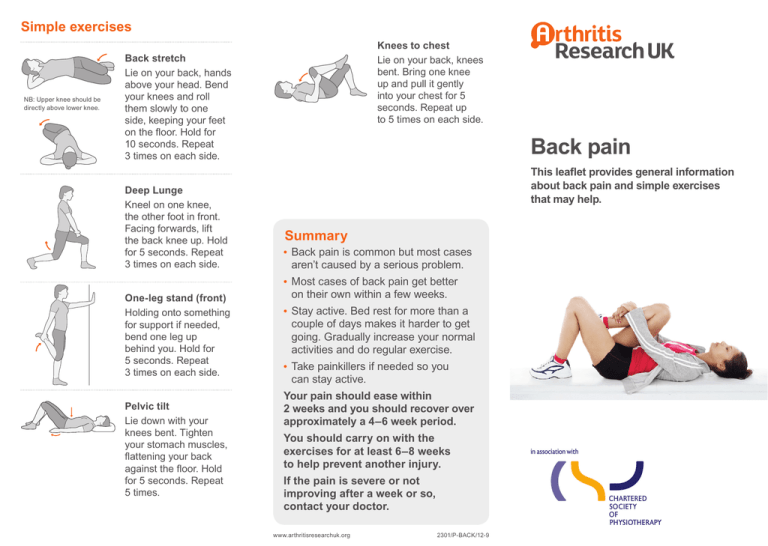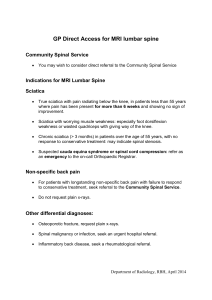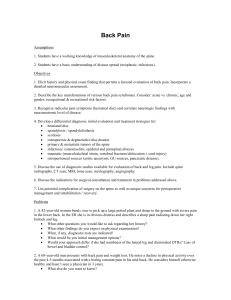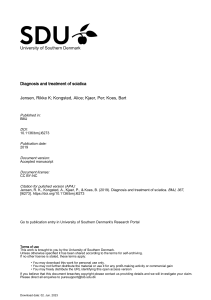Back pain
advertisement

Simple exercises NB: Upper knee should be directly above lower knee. Knees to chest Lie on your back, knees bent. Bring one knee up and pull it gently into your chest for 5 seconds. Repeat up to 5 times on each side. Back stretch Lie on your back, hands above your head. Bend your knees and roll them slowly to one side, keeping your feet on the floor. Hold for 10 seconds. Repeat 3 times on each side. Deep Lunge Kneel on one knee, the other foot in front. Facing forwards, lift the back knee up. Hold for 5 seconds. Repeat 3 times on each side. Back pain This leaflet provides general information about back pain and simple exercises that may help. Summary • Back pain is common but most cases aren’t caused by a serious problem. • Most cases of back pain get better One-leg stand (front) Holding onto something for support if needed, bend one leg up behind you. Hold for 5 seconds. Repeat 3 times on each side. Pelvic tilt Lie down with your knees bent. Tighten your stomach muscles, flattening your back against the floor. Hold for 5 seconds. Repeat 5 times. on their own within a few weeks. • Stay active. Bed rest for more than a couple of days makes it harder to get going. Gradually increase your normal activities and do regular exercise. • Take painkillers if needed so you can stay active. Your pain should ease within 2 weeks and you should recover over approximately a 4–6 week period. You should carry on with the exercises for at least 6–8 weeks to help prevent another injury. If the pain is severe or not improving after a week or so, contact your doctor. www.arthritisresearchuk.org 2301/P-BACK/12-9 How does the back work? What causes back pain? The back is a complicated structure built around the bones of the spinal column. The spinal column consists of 24 bones (vertebrae) sitting one on top of another. It sits on the pelvis and is topped by the skull. The bones of the spine are connected by discs at the front and facet joints at the back. The discs help to absorb loads on the spine and, with the facet joints, give the spinal column its flexibility. Sprains and strains Cervical spine Sciatica Back pain is sometimes linked with pains in the leg which are called sciatica. It affects the sciatic nerve that runs from the spine to the leg. The pain is felt anywhere from the buttock to the big toe. Other symptoms include numbness and tingling in the legs and feet. Thoracic spine Lumbar spine Sacroiliac joint Coccyx Facet joint Nerve roots from spinal cord to arm Back pain isn’t usually a sign of a serious medical condition – it’s much more likely that an awkward movement has pulled a muscle or sprained a ligament. Simple cases often improve within 4–6 weeks. Staying active and getting on with normal activities is one of the best ways to deal with back pain, but you can take painkillers if you need to. It’s very important to exercise the affected muscle to improve its strength, although you should rest if the muscle is in spasm. Unless you’re in severe pain you probably won’t need to see a doctor. Vertebra Disc Sciatica is caused by an irritation of the sciatic nerve – there’s nothing wrong with the leg itself. If you notice weakness of the muscles in your leg, especially if you can’t pull your foot up towards you, or if you lose bladder or bowel control, you should see your doctor urgently. What can be done to help? Exercise Exercise is the most important way that you can: • ease stiffness and pain • build up muscle strength and stamina • improve your flexibility and general fitness. If your back pain lasts a while, lack of movement can cause the muscles to become weak. This makes it more likely that you’ll strain them in future. It’s important that you don’t rest for too long and keep moving. Medication Painkillers like paracetamol and ibuprofen may help and you should use them if you need to. Take them regularly and at the recommended dose to help you control pain and allow you to continue exercising. Don’t wait until your pain is severe before taking painkillers. You shouldn’t take ibuprofen or aspirin if you’re pregnant or have asthma, indigestion or an ulcer until you’ve spoken to your doctor or pharmacist. Medication can have side-effects so you should read the label carefully and check with your pharmacist if you have any queries. Physiotherapy If your back pain is affecting your activity and is persisting, ask your GP about referral to a physiotherapist. Physiotherapy can help you to manage pain and improve your strength and flexibility. A physiotherapist can provide a variety of treatments, help you understand your problem and get you back to your normal activities. They can also give advice on how you can prevent symptoms returning in the future, for example by teaching the correct way to lift heavy objects.



